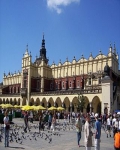Sukiennice
Archaeology »
Archaeological Monuments » Sukiennice
Sukiennice -
Sukiennice is located in Kraków, Poland.
Sukiennice monument was established on 1870.
Primary threats to Sukiennice :
Historical facts of Sukiennice :
- Introduction :
Sukiennice, also known as the Cloth Hall, is an iconic historical building situated in the heart of Krakow, Poland. With a rich and storied past dating back several centuries, this architectural gem has witnessed the city's transformation over the years. From a bustling trade center to a symbol of national identity, Sukiennice stands as a testament to Krakow's historical and cultural significance. In this essay, we will explore the historical facts that make Sukiennice a cherished landmark in Poland.
- Origins and Early History :
The origins of Sukiennice can be traced back to the 13th century when Krakow was a flourishing trade hub. Initially constructed as a modest gothic structure, it served as a market for cloth merchants, hence its name "Sukiennice" or "Cloth Hall." Over the centuries, the building underwent numerous renovations and expansions, gradually transforming into the magnificent Renaissance-style structure that we see today.
- Architectural Marvel :
Sukiennice's architecture is a harmonious blend of Gothic and Renaissance styles. The exterior facade boasts delicate arcades, elegant stonework, and ornate decorations. The stunning attic is adorned with beautiful allegorical figures, showcasing the artistic prowess of the era. Inside, visitors are greeted by a grand hall with a vaulted ceiling, supported by graceful columns, creating a captivating space for commerce and cultural exchange.
- Trading Hub and Economic Significance :
During the Middle Ages, Sukiennice was the center of Krakow's bustling trade activity. It became a crucial meeting place for merchants and traders from various parts of Europe, facilitating the exchange of goods and ideas. The trade of cloth, spices, and other commodities brought prosperity to the city and contributed significantly to its economic growth.
- Renaissance Rebirth :
In the 16th century, Krakow's rulers recognized the significance of Sukiennice and invested in its expansion and renovation. The building underwent a transformation, acquiring its characteristic Renaissance facade, which showcased Poland's cultural and artistic aspirations during that period.
- Cultural and Social Gatherings :
Beyond its commercial role, Sukiennice also played a vital role in hosting cultural and social gatherings. Festivals, fairs, and celebrations were held within its walls, bringing people from different backgrounds together. It served as a place where artists, poets, and musicians would congregate, contributing to the flourishing cultural scene of Krakow.
- The National Museum :
In the 19th century, Sukiennice underwent a significant transformation when it became the home of the Sukiennice National Museum. The museum's establishment aimed to promote and preserve Poland's rich cultural heritage and artistic achievements. It houses an impressive collection of Polish art, including paintings, sculptures, and decorative arts, making it one of the most important cultural institutions in the country.
- A Witness to History :
Sukiennice has borne witness to several historic events over the centuries. It stood resilient through political changes, wars, and occupations, symbolizing the enduring spirit of the Polish people. During the partitions of Poland in the late 18th century, Sukiennice found itself within Austrian-controlled territory, yet it remained a source of pride and a symbol of national identity for the Poles.
- UNESCO World Heritage Site :
In recognition of its cultural and historical significance, Sukiennice was designated as a UNESCO World Heritage Site in 1978. This prestigious title solidifies its importance not only to Poland but also to the global cultural heritage.
- Conclusion :
Sukiennice, the Cloth Hall of Krakow, stands as a living testament to the city's vibrant history and the enduring spirit of its people. From its humble origins as a trading hub to its transformation into a cultural treasure, Sukiennice continues to captivate visitors with its architectural brilliance and historical significance. As one of Poland's most beloved landmarks, it serves as a poignant reminder of the country's rich heritage and its contributions to the world of art and culture.

